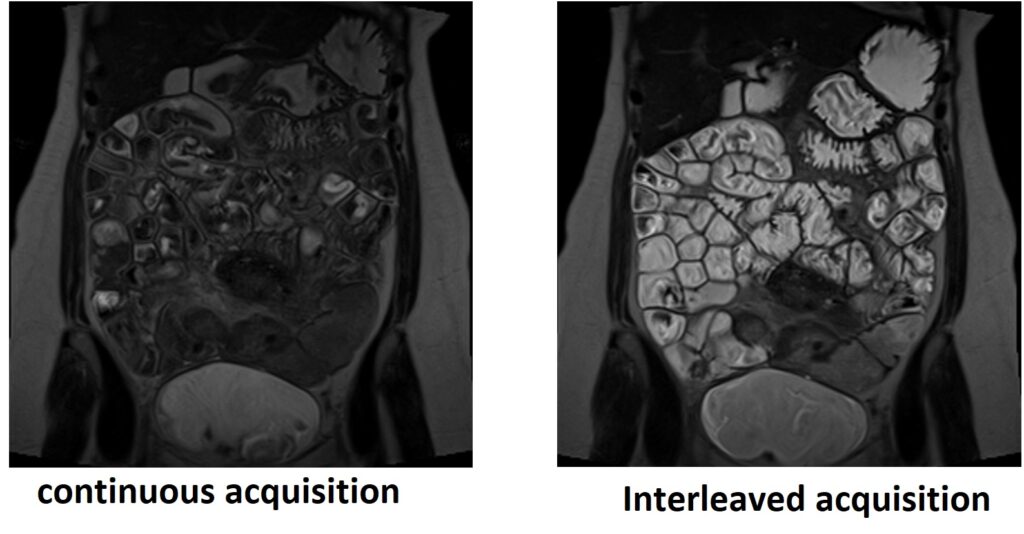Cross Talk \ Slice-Overlap Artifact
Cross-talk artifact in MRI occurs when slice groups overlap or slices are positioned too closely together. This artifact is primarily caused by the slightly curved shape of the excitation pulse, which can inadvertently excite not only the intended tissue but also the adjacent or overlapping tissue. As a result, certain areas of tissue may be excited multiple times within a single repetition time (TR), preventing proper relaxation and leading to the loss of signal.
The impact of cross-talk artifact on the image can be observed as a loss of signal intensity, particularly in all slices except the first slice of the set. This artifact commonly manifests as black bands that may overlay the region of interest, particularly in axial lumbar spine imaging.

Here are some strategies to minimize or avoid Cross-talk artifact :
Reduce Slice Overlap: In lumbar spine imaging, it is recommended to minimize the overlap of slices as much as possible while considering the anatomical constraints. By reducing the slice overlap, the artifact can be “thrown” posteriorly away from the area of interest, minimizing its impact.
Avoid Small Slice Gaps: It is important to avoid small slice gaps, especially in inversion recovery sequences, which are particularly susceptible to cross-talk artifacts. A slice gap of less than 10% should be avoided to prevent the artifact from affecting adjacent slices

Utilize 3D Imaging: When minimal slice gaps are necessary, the use of three-dimensional (3D) imaging techniques can help mitigate cross-talk artifact. With 3D imaging, the slice gap can be minimized, resulting in fewer opportunities for cross-excitation between adjacent slices.
Increase matrix size: Increasing the matrix size can reduce the impact of chemical shift artifact. However, this may also lead to a reduction in SNR.
Implement Interleaved Acquisition: Interleaved acquisition is a technique where alternate slices are selected, leaving sufficient relaxation time between the excitation of adjacent slices. This approach helps reduce the occurrence of cross-talk artifact by allowing ample time for proper relaxation before exciting the adjacent slice.

References:
- Krupa K, Bekiesińska-Figatowska M. Artifacts in Magnetic Resonance Imaging. Pol J Radiol. 2015;80:93-106. Published online 2015 Feb 23. doi: 10.12659/PJR.892628. PMCID: PMC4340093. PMID: 25745524.
- Noda, C., Venkatesh, B. A., Wagner, J. D., Kato, Y., Ortman, J. M., & Lima, J. A. C. (2022). Primer on Commonly Occurring MRI Artifacts and How to Overcome Them. RadioGraphics, 42(3).
- Lee, S.-Y., Cho, J.-H., Lee, H.-K., Cho, M.-S., Park, C.-S., Kim, E.-C., Kim, S.-K., Dong, K.-R., Chung, W.-K., Shin, J.-W., Kim, Y.-J., & Cho, Y.-K. (2012). A study on a method to reduce the effect of the cross-talk artifact in a simultaneous, multiple-slice, plane, oblique MRI scan. Journal of the Korean Physical Society, 61, 807–814. Published: 12 September 2012.
- Lavdas, E., Mavroidis, P., Kostopoulos, S., Glotsos, D., Roka, V., Koutsiaris, A. G., Batsikas, G., Sakkas, G. K., Tsagkalis, A., Notaras, I., Stathakis, S., Papanikolaou, N., & Vassiou, K. (2013). Elimination of motion, pulsatile flow and cross-talk artifacts using blade sequences in lumbar spine MR imaging. Magnetic Resonance Imaging, 31(6), 882-890. doi:10.1016/j.mri.2013.03.006


